Ryokan “Kokuya” hot spring and meal review with Spirited Away bathhouse.
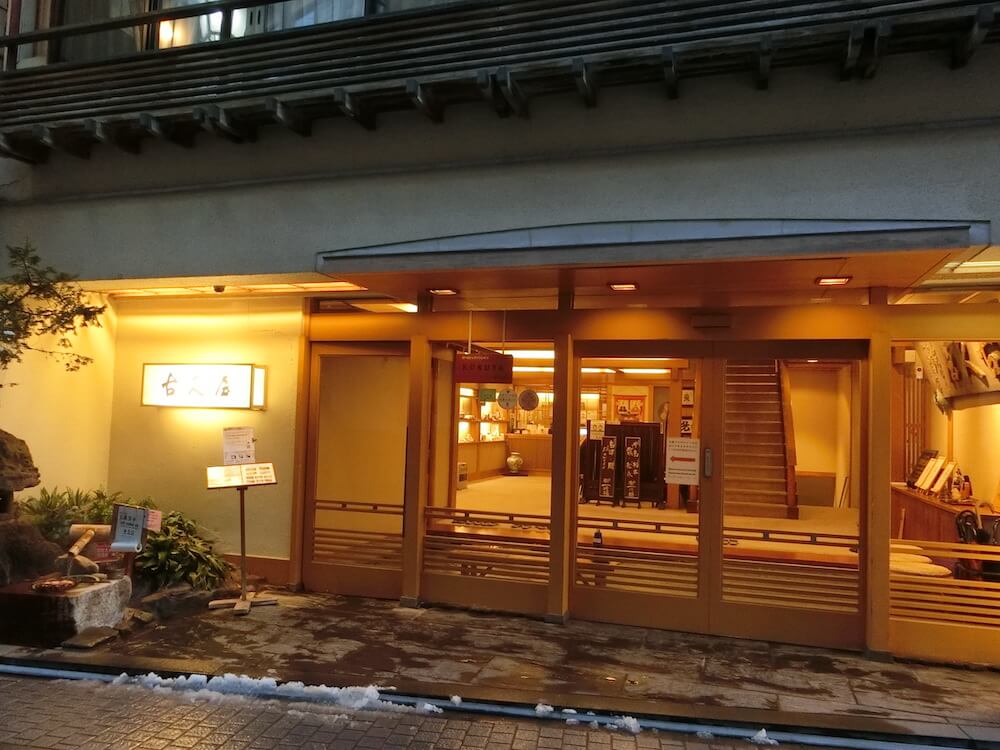
Shibu Onsen is a historical hot spring town that opened 1300 years ago, located in Nagano prefecture, just over two hours from Tokyo by Shinkansen. Many of the buildings in Shibu Onsen were built during the early Showa era (around the 1930s), but the nostalgic landscape is maintained.
Among them, there is the historical hot spring inn called “Kanaguya“, which is said to have been the model of the Spirited Away’s bathhouse.
This time, we would like to introduce the hot spring inn “Kokuya” in front of Kanaguya.
At first I was wanted to stay at Kanaguya, but although Kanaguya is a nice building with a long history, it is too cold to stay in the winter, and because of Kokuya’s hot springs and food reputation I chose Kanaguya it instead.
As a result, I was very satisfied with the hot springs and the food, so I would like to discuss the advantages and disadvantages of staying at Kokuya.
Pros and Cons
Kokuya is a good choice for people who…
- want to enjoy various hot springs and baths
- want to enjoy the private bath as many times as you like
- want to enjoy plenty of local Shinshu ingredients
- want to stay at a traditional Japanese style hot spring inn
Unfortunate points of Kokuya are…
- Many stairs and no elevator
- It’s like a maze of complex buildings
For reservations and prices, please check below!
Now, let me introduce the details of Kokuya.
Hot springs ~ 9 baths with 6 sources ~
Kokuya has 6 hot spring sources, 9 bath areas, and 14 total baths. Here, I would like to introduce my two recommendations.
First of all, if you want to enjoy all of the hot springs, we recommend the open-air bath called “福六の湯 (Fukuroku no Yu)” where you can enjoy all 6 hot spring sources. There are 6 bathtubs made of cypress, each with a different source. Since each sources is a different temperature, the bathtub has a faucet, so you can adjust the temperature yourself.
It’s fun to visit hot springs here, but the temperature of the source is so high that you can’t take a bath without adding water. One of the sources is around 40 degrees Celsius (104 F), while the other five have temperatures above 50 degrees Celsius (122 F).
In addition, there is a source which is about 90 degrees (194 F), and even a little touch can be dangerous. I tried three sources while adding water.
According to the inn, most people enjoy two of the six sources.
There are also acidic sources (地獄の湯 “Hell’s hot springs”), but most are alkaline and mild hot springs.
Next, for those who want to enjoy the hot springs slowly and spaciously, “一茶の湯 (Issa no Yu)” is recommended.
This is an open-air bath that can accommodate 20 people at the same time. If it’s a one-day hot spring in Tokyo, it’s spacious enough to accommodate 40 people.
The temperature of the hot spring has variations due to the size, but it was good because I could enjoy it at my favorite temperature.
In addition, there are baths with different atmospheres, such as an open-air bath where you can play music and a cypress bath, so it was fun to try the various hot springs that were available.
In many baths, a source that contains a lot of metasilicic acid which is said to make your skin beautiful.
Japanese-style guest rooms with open-air baths are also available
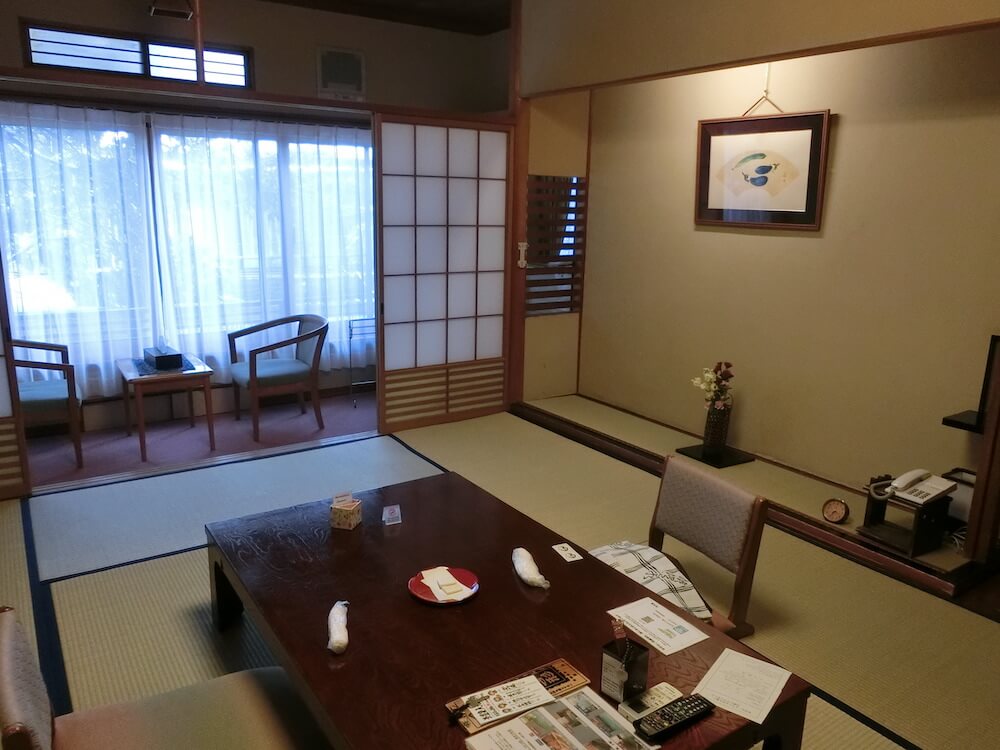
The room I stayed in is the simplest type, but Kokuya also has rooms with an open-air bath.
The open-air bath in that room is very luxurious with an hot spring jet bath where you can enjoy background music. It looks good for special occasions such as anniversaries.
At this stay, all the baths could be reserved for private use as a preventive measure against COVID, so I booked a simple type that does not have a bath in the room.
Kokuya has existed for more than 400 years, but the current building was built in 1957 and has been renovated over the years, so the interior of the room is of course clean, but it still feels historical. The room is a typical with a TV, refrigerator, yukata and amenities.
When I arrived, there were tea confectionery and the key to the public hot springs (explained at the end) on the table.
Even if you don’t reserve a guest room with an open-air bath, you will still enjoy the variety of sources and baths that the Ryokan has available.
Also, because there is no elevator, in order to go to the restaurant or hot spring baths from the guest room, you will have to go up and down the stairs. There are also relatively long and steep stairs, so we do not recommend staying for people who have any difficult walking.
In addition, because it is a building that has been repeatedly expanded and renovated, the inside of the building is complicated like a maze, and the room is a little far from the hot spring baths.
There are guides and arrows in the hall in some places, so if you follow them, you will get to your destination, but it can be a bit confusing. However, it was like an expedition which was fun.
For your information, in the room, you should be careful about opening the window, as monkeys might come in aiming for sweets. I didn’t have the reason to leave the windows open because of the air conditioner, but be careful, just in case.
A meal that uses plenty of local Shinshu ingredients

Meals are served at the restaurant. This was a small dining room with booths for enjoying a full course.
Dinner is a seasonal course that uses ingredients from Shinshu.
Dishes were made with ingredients that you wouldn’t normally get in Tokyo, such as chopped carp with miso and seasoning (namero), trout pie wrapping, and Shinshu beef where the cows were raised eating apples, it was delicious with a very delicate taste. The taste is not strong, there is no carp or trout smell, and it is delicious!
It is highly recommended for those who want to taste the ingredients of Shinshu.
The hot dishes were served in a hot and fresh state, and the timing of serving was just right, and the service was very satisfying.
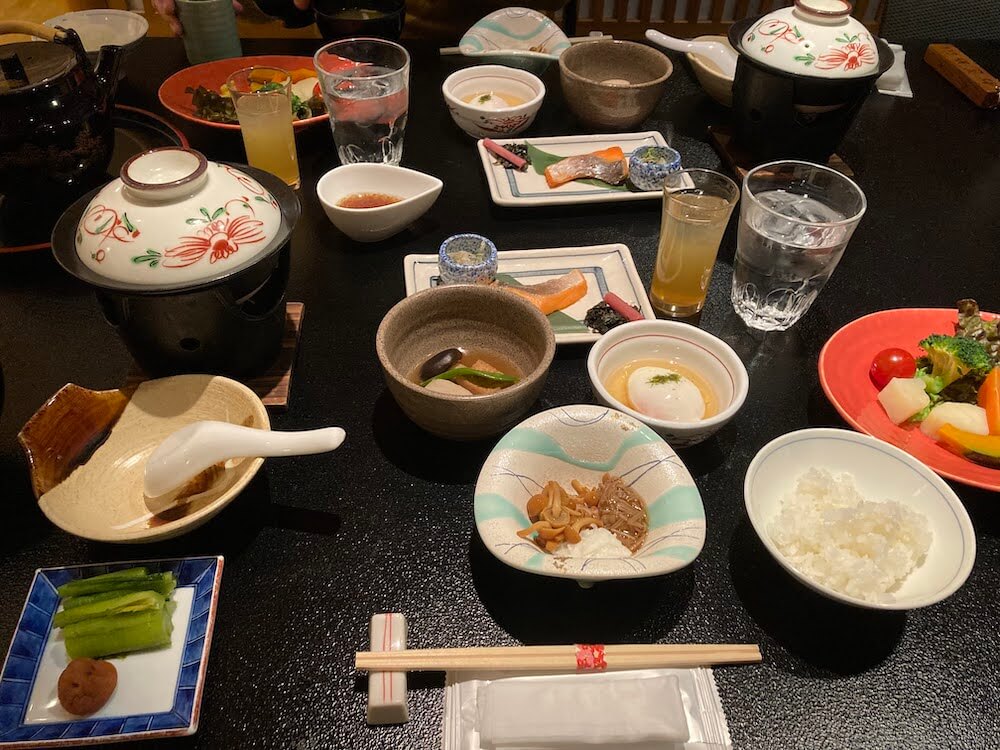
And you can choose breakfast between Japanese and Western dishes.
I chose Japanese food. I enjoyed eating various ingredients little by little.
The apple juice was so delicious that I woke up.
For those who are not good at raw eggs, hot spring eggs can be served as a cooked egg dish.
9 outdoor hot spring tours
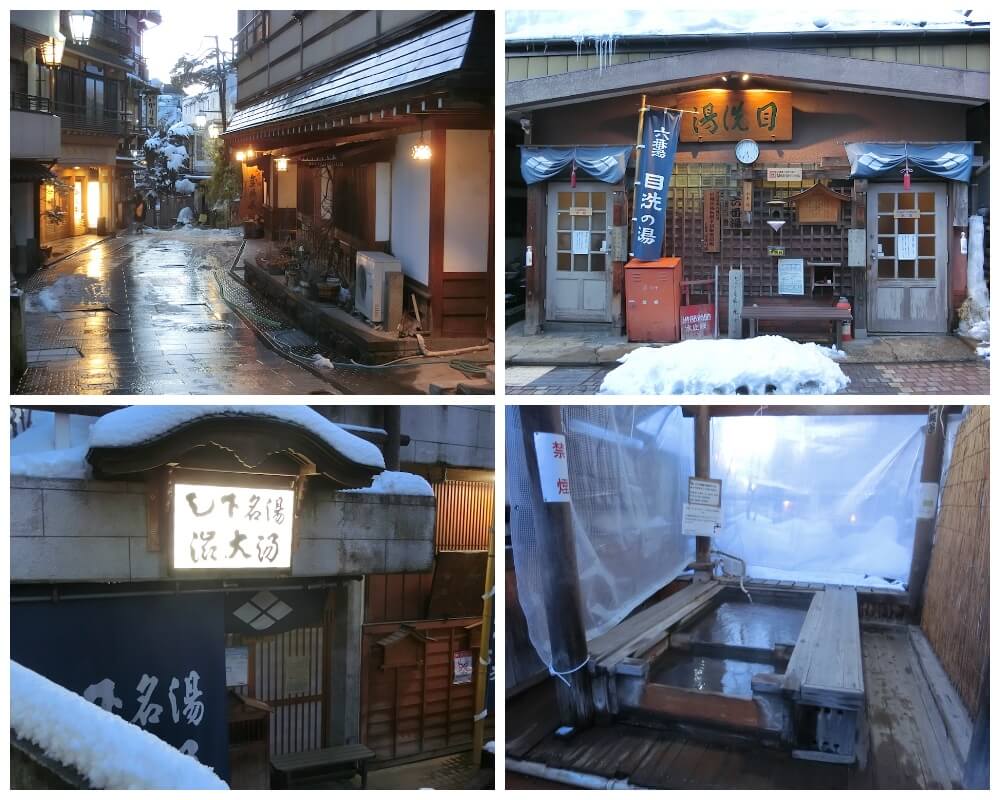
If you stay at Shibu Onsen, you can enjoy not only the inn but also 9 indoor hot springs. The ryokan has a key exclusively for guests, and you can use it to take a free bath in these hot springs from 6 am to 10 pm.
There are indoor hot springs from No. 1 to No. 9 (the above photo shows only No. 6 and No. 9 with foot bath), and only No. 9 hot water can be used for 500 yen by non-guests.
The road in front of the inn has a pipe running underground to supply hot springs, so even on a heavy snow day, the snow was almost melted and I could walk to the baths with clogs.
Hot spring No. 9 called “Oyu”, and a foot bath in the immediate vicinity of Kokuya. The foot bath has a high temperature, but it may be just right in the cold season.
It seems that the No. 6, the eye-washing hot spring, is also popular with women. If you have time, please come visit there.
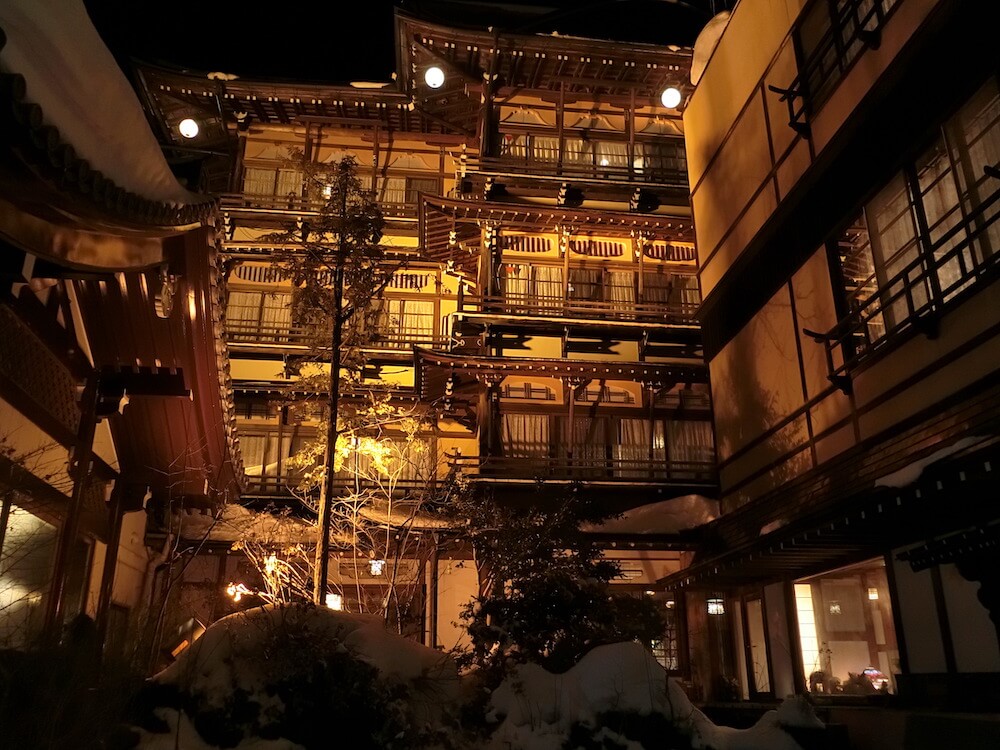
Also, at night, the illumination of “Kanaguya” in front of Kakuya looked beautiful. You can feel the atmosphere of Spirited Away’s bathhouse.
Surrounding tourist spots
A nearby tourist attraction is Jigokudani Wild Monkey Park, where you can see Japanese macaques entering the hot springs. At Kokuya, there is a drop-off service to the park. However, we gave up because it takes about 30 minutes from the drop-off entrance of the park. I would however like to visit next time.
Another easily accessible spot is Zenkoji Temple. In addition to visiting the main hall of the national treasure, you can also visit the many shops along the road leading to it, and also there is projection mapping and illuminations at night in winter, so you can enjoy your visit in various ways.
It was a healing trip where we enjoyed sightseeing in Nagano while also relaxing the hot springs at Shibu Onsen.
Access from Tokyo
Access from Tokyo is very easy.
You can get from Tokyo Station to Nagano Station with a single transfer on the Hokuriku Shinkansen (time required 1 hour and 20 minutes), and from Nagano Station to Yudanaka Station on the Nagano Electric Railway (by limited express, 45 minutes).
Kokura offers a car pick-up service from Yudanaka Station.
Since snow can pile up on the road in winter, I think that it is safer to travel by Shinkansen, train, or pick-up service rather than by driving on an unfamiliar winter road.

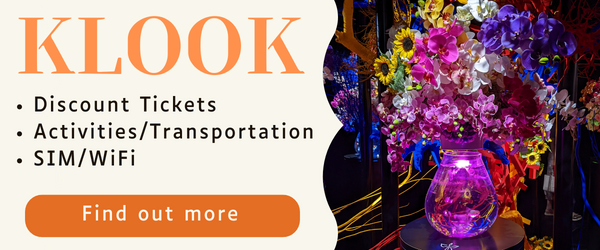

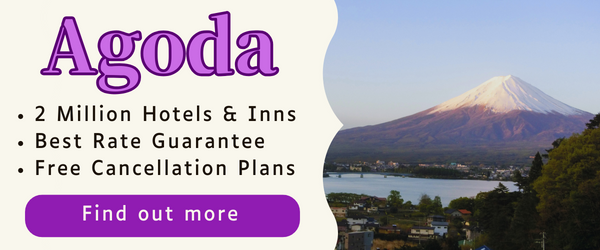
Comments